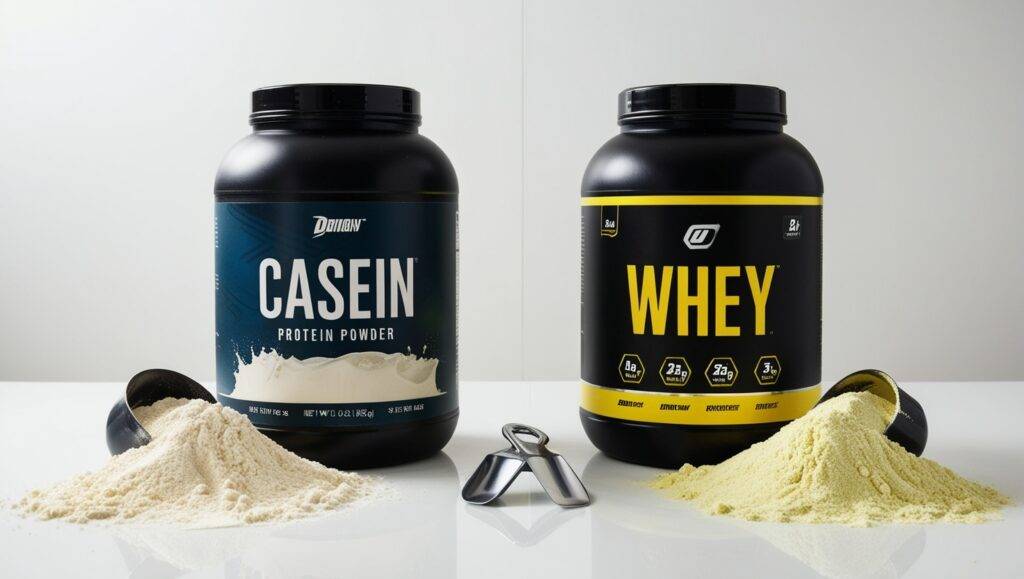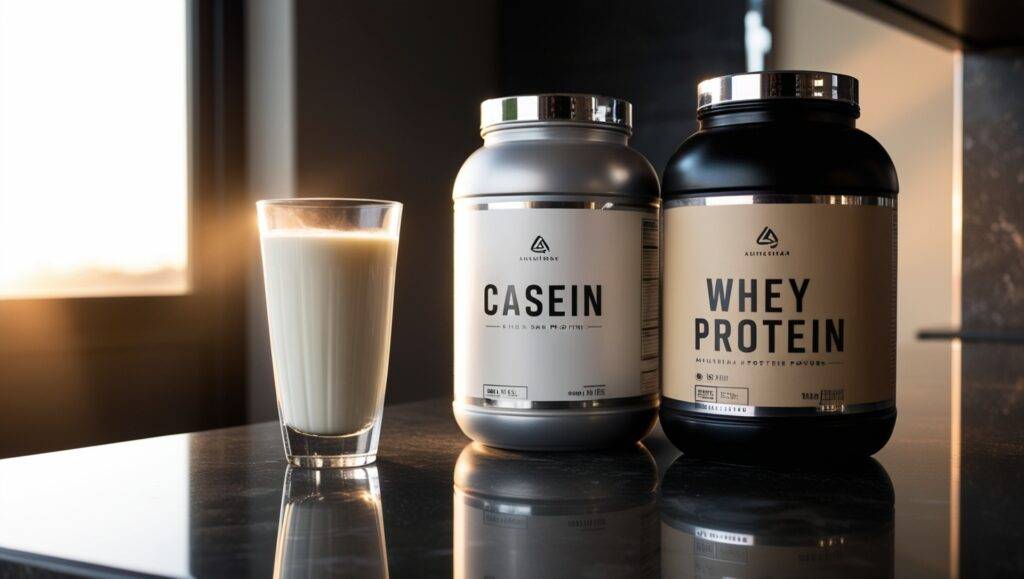Are you ready to supercharge your workout results? Dive into the ultimate protein showdown and discover which muscle-building champion will take your fitness to the next level!
Introduction
In the world of fitness and nutrition, protein reigns supreme. But when it comes to choosing the right protein supplement, the debate between casein and whey often leaves gym-goers scratching their heads. Both derived from milk, these protein powerhouses have unique properties that can significantly impact your fitness journey. In this article, we’ll unravel the mysteries of casein and whey proteins, helping you make an informed decision that aligns with your fitness goals.

What exactly are casein and whey proteins?
Casein and whey are the two primary proteins found in milk, with casein making up 80% and whey 20% of milk protein. Both are complete proteins, offering all the essential amino acids your body needs. These supplements come from cheese production and are key in the fitness world, each with its own benefits for muscle building and recovery. They split during cheese making, with casein becoming curds and whey staying liquid.
The main difference between casein and whey is how fast they are digested. Whey is quickly absorbed by your body in about 20 minutes. Casein, on the other hand, takes longer, with peak absorption around 3 to 4 hours after consumption. This speed affects how these proteins help your fitness goals.
Furthermore, whey protein leads the race in the production of muscle protein synthesis. According to studies, it can boost muscle protein synthesis more than casein and soy. But casein shouldn’t be overlooked. Its slow release is perfect for steady protein delivery, especially during sleep.

Casein: The Slow and Steady Contender
Casein acts as a time-release protein, turning into a gel in the stomach. This gel slowly releases amino acids over hours. It can take up to five hours for the body to fully digest and absorb it. This slow digestion helps you stay full for three to five hours after eating.
Casein is great for keeping muscles strong. It gives a steady supply of amino acids, perfect before long periods without food, like at night. Amino acid levels stay high for about four to five hours after eating casein protein.
There are two main types of casein in supplements: micellar and caseinates (sodium, potassium, or calcium). Both have all nine essential amino acids, making casein a complete protein. Its slow digestion makes it ideal for growth and recovery while you sleep.
Casein also has health perks beyond muscle support. It’s full of calcium and phosphorus, which are good for bones and teeth. A single serving of casein protein powder can give you half the daily calcium you need, making it a key supplement for health.
| Benefit | Description |
|---|---|
| Slow-Release Protein | Provides steady amino acid supply over 3-4 hours |
| Overnight Recovery | Supports muscle repair during sleep |
| Appetite Control | Helps reduce food intake and manage weight |
| Muscle Preservation | Decreases protein degradation by one third |
| Nutrient-Rich | High in calcium and phosphorus for bone health |
But, it’s important to know that casein has 20% less leucine than whey. For your basic information, leucine is key for muscle growth. This difference affects how these proteins help with different fitness goals.

Whey: The Fast-Acting Muscle Builder
Whey protein is great for muscle repair and recovery after exercise because of its rapid absorption and immediate impact. Let’s break down its benefits:
1. Quick absorption: Whey protein is known for its fast digestion. It boosts amino acid levels in the body within 60 to 90 minutes. This makes it perfect for post-workout recovery. Blood amino acid levels peak and last for 2 to 3 hours after eating.
| Protein Type | Digestion Time | Peak Amino Acid Levels |
|---|---|---|
| Whey | 20 minutes | 2-3 hours |
| Casein | Slow-digesting | 3-4 hours |
2. High in BCAAs: Whey is rich in branched-chain amino acids. It has more sulfur-based amino acids and BCAAs than casein, particularly leucine, which is crucial for muscle protein synthesis. Qunatitaviely, whey has around 9% (approx estimated) leucine to casein which is about 7% (approx estimated).
3. Versatility: Its neutral flavor and easy mixing properties make whey a popular choice for protein shakes and baked goods.
Types of Whey Protein
There are three main types of whey protein:
1. Whey Concentrate: The least processed form.
2. Whey Isolate: Higher protein content with less fat and lactose.
3. Whey Hydrolysate: Pre-digested for faster absorption.
Also, read:
A Comprehensive Guide to Whey Protein.

Key Differences: Casein vs Whey
1. Digestion and Absorption Rates
Casein and whey proteins have different ways of being digested. Whey protein is faster, with amino acids entering your bloodstream in just 20 minutes. It absorbs about 8-10 grams per hour, making it a fast protein source.
Casein takes longer to digest. It forms a gel in your stomach, leading to slow digestion. This slow digestion affects how it absorbs amino acids, with levels peaking after 3-4 hours and staying high for up to 7 hours.
These differences in absorption rates are key for planning your protein intake. For the best muscle growth, I suggest eating 20-25 grams of protein at each meal.
Casein protein before bed can help with recovery overnight. This makes it great for nighttime protein needs. Whey is best after workouts because it absorbs quickly.
Knowing how these proteins digest helps plan your protein intake. By mixing fast-acting whey and slow-releasing casein, you keep amino acids flowing for muscle growth and recovery.

2. Amino Acid Profiles Compared
Let’s look at their amino acid profiles to see how they compare.
Essential Amino Acids in Casein and Whey
Casein and whey are packed with essential amino acids vital for muscle growth. Whey has about 43% essential amino acids, while casein has around 34%. This difference impacts how they help build muscle.
Leucine Levels and Muscle Protein Synthesis
As discussed earlier, leucine triggers muscle protein synthesis. Whey has more leucine, about 9% (approx estimated), than casein. This makes whey effective for muscle growth right after you eat it.
| Protein Type | Essential Amino Acids | Leucine Content | Protein per Serving |
|---|---|---|---|
| Whey | 43% | 9% | 24g |
| Casein | 34% | 7% | 24g |
To summarise, whey is better for quick muscle protein synthesis. Casein, on the other hand, releases amino acids slowly for long-term muscle support. Both have 24 grams of protein per serving but are best for different muscle-building plans.

Knowing the amino acid profiles helps pick the right protein for your muscle goals. Whether you choose fast-acting whey or slow-releasing casein, both are key for protein quality in your diet.
Nutritional Comparison
Casein and whey proteins are similar in nutrition but have some differences. Let’s look at their protein content, calories, and micronutrients.
A scoop of whey protein has 110 calories, 24g of protein, 1g of fat, and 2g of carbs. Casein protein has 120 calories, 24g of protein, 1g of fat, and 4g of carbs per scoop. This small difference in carbs means a tiny calorie difference between the two.
| Nutrient | Whey Protein | Casein Protein |
|---|---|---|
| Calories | 110 | 120 |
| Protein | 24g | 24g |
| Fat | 1g | 1g |
| Carbohydrates | 2g | 4g |
Both proteins are low in fat and carbs, fitting many diets. But, they vary in micronutrients. Casein has more calcium, giving about 50% of the daily need per serving, while whey gives 8%.
Again, whey protein is rich in BCAAs while casein has bioactive peptides that help the immune and digestive systems, lower blood pressure, and improve mineral absorption.

Timing and Usage Strategies
Protein timing is key for workout nutrition and muscle recovery. Knowing when to use different proteins can greatly improve fitness results.
When to Use Casein Protein
Casein protein is great for fasting or before sleep. It’s 80% of dairy milk protein and digests slowly, releasing amino acids over time. This slow release is perfect for muscle repair and maintenance at night.
Ideal Times for Whey Protein Consumption
By this time, you know that whey protein makes up 20% of dairy milk protein and is quickly absorbed. Therefore, it’s best taken around workout times for quick muscle repair and growth.
Combining Both for Optimal Results
For the best results, mix both proteins. Use whey after workouts and casein before sleep. This combo gives both quick and long-lasting amino acid support, helping with muscle growth and recovery.
| Protein Type | Best Time to Consume | Benefits |
|---|---|---|
| Casein | Before bed, during fasting periods | Prolonged amino acid release, overnight muscle maintenance |
| Whey | Around workouts | Rapid absorption, immediate muscle repair and growth |
| Combination | Post-workout (whey) and before bed (casein) | Optimized muscle growth and recovery throughout the day |
Pro Tip: It’s advised to eat 25 to 30 grams of high-quality protein in each meal for daily needs. Choose products with 20 to 30 grams of protein and 2.5 to 3 grams of leucine for best muscle protein synthesis.
Making the Right Choice for Your Fitness Goals
By now you have a rock-solid understanding of whey protein and casein protein. To make your life a little easier here is a set of quick guidelines, on which protein powder should you pick based on your fitness goals.
Muscle Building: If your primary goal is muscle growth, consider using both. Whey post-workout for immediate recovery, and casein before bed to prevent muscle breakdown overnight.
Weight Loss: Casein’s satiating effect may be beneficial for curbing appetite, but whey’s versatility makes it easier to incorporate into low-calorie meals.
Endurance Athletes: A combination of both can be beneficial. Whey for quick recovery between training sessions, and casein for sustained energy during long events.
General Health and Wellness: If you’re simply looking to supplement your protein intake, whey is a cost-effective and versatile option.
Remember, while protein supplements can be beneficial, they should complement a balanced diet rich in whole foods. No supplement can replace the nutrients found in a varied, healthy eating plan.

Potential Side Effects and Considerations
Casein and whey protein come from milk and might make people with dairy allergies or intolerances feel bad. This can result in stomach pain, cramps, less hunger, nausea, headaches, tiredness, and acne. Some might feel bloated or gassy, especially with large protein supplement doses. Therefore, it’s important to start with small amounts when trying new supplements.
Alternatives for Those with Sensitivities
If you’re sensitive to dairy proteins, don’t worry! There are other choices. Plant-based options like pea, rice, or soy protein work well. For those who can handle some dairy, whey protein hydrolysate (WPH) is easier to digest and less likely to cause allergies. Always talk to a healthcare professional before changing your diet or supplements.

Also, read:
Best Protein Powder for Lactose Intolerance: Full Guide.
Conclusion
In the casein vs whey protein battle, there’s no clear winner – both have their unique strengths. The best choice depends on your individual fitness goals, dietary preferences, and lifestyle. By understanding the properties of each protein type, you can strategically incorporate them into your nutrition plan to maximize your fitness results.
Whether you choose the slow-release muscle protection of casein, the rapid absorption of whey, or a combination of both, remember that consistency in your overall diet and training regimen is key to achieving your fitness goals. So, power up your protein game and watch your performance soar to new heights!
Key Takeaways
- Casein and whey are both high-quality milk proteins
- Whey is fast-absorbing, ideal for post-workout recovery
- Casein provides a slow-release protein source
- Both proteins support muscle growth and recovery
- The choice depends on individual fitness goals and timing
- Combining both proteins can offer comprehensive benefits
FAQs
What are the key differences between casein and whey protein?
Casein and whey protein differ in how they digest, their amino acid mix, and their impact on muscle growth. Casein is slow to digest, giving a steady flow of amino acids for hours. It’s great for muscle recovery at night and helps control hunger. Whey, on the other hand, is quickly absorbed and packed with BCAAs, especially leucine, which boosts muscle protein making. It’s best for recovery after exercise, while casein keeps muscle mass over time.
Which protein is better for muscle growth and recovery?
Both casein and whey are good for muscle growth and recovery but in different ways. Whey speeds up muscle protein making with its fast absorption and lots of leucine, perfect for after workouts. Casein slowly releases amino acids, preventing muscle loss over longer periods. Mixing both can help muscle growth, with whey post-workout and casein before bed or when not eating.
When should I consume casein protein?
The best time for casein is before bed or when not eating for a while, thanks to its slow digestion. It keeps muscle mass and feeds your muscles steadily over time.
When is the best time to take whey protein?
Take whey protein right before, during, or after exercise for quick recovery and to boost muscle making.
Can I take both casein and whey?
Absolutely! Many athletes use whey post-workout and casein before bed for round-the-clock muscle support.
How do the nutritional profiles of casein and whey differ?
Casein and whey are similar in nutrients but have some differences. A scoop of whey has about 110 calories, 24 grams of protein, 1 gram of fat, and 2 grams of carbs. Casein has similar amounts but more calories and carbs. Casein also has more calcium, offering about 50% of the daily need per serving, while whey gives 8%.
Can people with lactose intolerance or milk allergies consume casein and whey?
People with milk allergies or lactose intolerance might have trouble with casein and whey because they’re dairy-based. They might feel bloated or have gas. For these issues, there are lactose-free or hydrolyzed proteins. Plant-based options like peas, rice, or soy can also work as substitutes.

